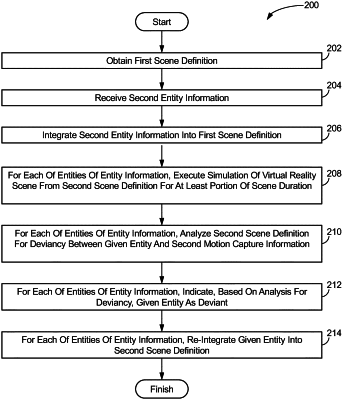| CPC G06T 19/006 (2013.01) | 14 Claims |

|
1. A system configured to facilitate animation, the system comprising:
one or more physical processors configured by machine-readable instructions to:
obtain a first scene definition that defines a virtual scene, the first scene definition including entity information for entities that defines at least integrated motion capture information of the entities within a virtual setting during portions of a scene duration from a scene beginning to a scene end;
receive supplemental entity information, the supplemental entity information defining at least supplemental motion capture information during a particular portion of the scene duration, wherein the portions during which the motion capture information for the entities occur and the particular portion of the scene duration have at least some overlap;
integrate the supplemental entity information into the first scene definition such that a second scene definition is generated, the second scene definition including the first scene definition and the supplemental entity information, wherein the integrated supplemental motion capture information affects the motion capture information of the entities;
for each of the entities of the entity information:
execute a simulation of the virtual scene from the second scene definition for at least a portion of the scene duration;
analyze the second scene definition for deviancy between a given entity and the supplemental motion capture information, wherein the deviancy characterizes the motion capture information of the given entity as incompliant with the supplemental motion capture information based on the integration of the supplemental motion capture information;
indicate, based on the analysis for deviancy, the given entity as deviant; and
re-integrate the given entity into the second scene definition.
|